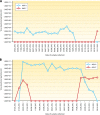Adenovirus infections in immunocompetent and immunocompromised patients
- PMID: 24982316
- PMCID: PMC4135893
- DOI: 10.1128/CMR.00116-13
Adenovirus infections in immunocompetent and immunocompromised patients
Abstract
Human adenoviruses (HAdVs) are an important cause of infections in both immunocompetent and immunocompromised individuals, and they continue to provide clinical challenges pertaining to diagnostics and treatment. The growing number of HAdV types identified by genomic analysis, as well as the improved understanding of the sites of viral persistence and reactivation, requires continuous adaptions of diagnostic approaches to facilitate timely detection and monitoring of HAdV infections. In view of the clinical relevance of life-threatening HAdV diseases in the immunocompromised setting, there is an urgent need for highly effective treatment modalities lacking major side effects. The present review summarizes the recent progress in the understanding and management of HAdV infections.
Copyright © 2014, American Society for Microbiology. All Rights Reserved.
Figures





References
-
- Rowe JP, Huebner RJ, Gilmore LK, Parrott RH, Ward TG. 1953. Isolation of a cytopathogenic agent from human adenoids undergoing spontaneous degeneration in tissue culture. Proc. Soc. Exp. Biol. Med. 84:570–573 - PubMed
Publication types
MeSH terms
LinkOut - more resources
Full Text Sources
Other Literature Sources

